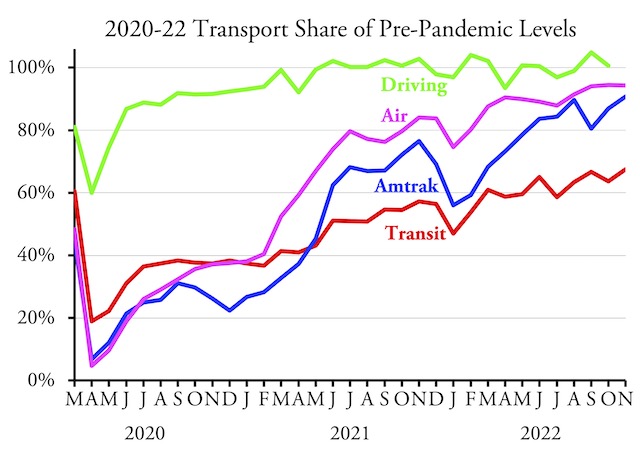Amtrak carried 90.8 percent as many passenger-miles in November 2022 as it did in November 2019, according to the monthly performance report released by the company last week. This is the first time since the pandemic that it has exceeded 90 percent of pre-pandemic numbers.
Amtrak remains behind air travel, which first breached 90 percent in April 2021. Yet it appears that Amtrak, unlike transit, will eventually come pretty close to 100 percent of pre-pandemic numbers.
Amtrak’s long-distance trains are doing better, relative to pre-pandemic numbers, than trains in the Northeast Corridor or state-supported day trains. November ridership on the long-distance trains was 96 percent of 2019 numbers, compared with 87 percent in the Northeast Corridor and 78 percent for state-supported trains. Passenger-miles on long-distance trains were actually 18 percent greater in November 2022 than 2019, while Northeast Corridor passenger-miles were down 2 percent and state-supported trains were down 24 percent.
The average length of a long-distance trip grew by nearly 24 percent from 491 to 607 miles. Trip lengths in the Northeast Corridor grew by 13 percent, but trip lengths on state-supported trains shrank by 3 percent.
Amtrak is putting nearly all of the $80 billion windfall from the infrastructure bill into more state-supported trains. Yet these are the trains that are doing the worst following the pandemic. It seems likely that people are choosing to drive rather than take the train on short trips such as Chicago-St. Louis, Portland-Seattle, or Sacramento-San Francisco.
Despite the lower passenger miles, Amtrak’s November ticket revenues were 1 percent greater than in November 2019. However, Amtrak’s basic operating costs — labor, fuel, advertising, and so forth — were 26 percent greater. This nearly doubled Amtrak’s basic operating losses, which went from $70.2 million in November 2019 to $138.1 million in November 2022.
These basic operating costs don’t include depreciation, pension and health care, and certain other costs that Amtrak pretends aren’t real. These were 9 percent greater than in 2019 and, when these costs are added, Amtrak’s total operating losses grew by more than 50 percent from $145 million in November 2019 to $220 million in November 2022.
What this means is that Amtrak ridership may be recovering, but at great expense. Moreover, the recovery is mainly in the Northeast Corridor and on long-distance trains, while much of the added expense is for state-supported trains. This suggests that the increase in costs is probably more because Congress has happily thrown money at Amtrak than because those extra costs were really needed to boost ridership. That should be little comfort to taxpayers who will ultimately have to pay for these losses.









50 years of existence and all that money to spend in 2023 and yet Amtrak can’t figure out how to treat their customers like anything but chattel when they have a 29 hour delay. Oi.